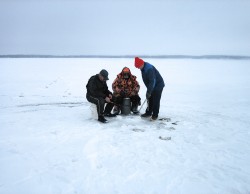Arts | September 28th, 2016

Something that has had its tenuous definition morph dramatically over the course of human history is art. From cave paintings depicting the hardships of Paleolithic life to Renaissance frescoes and sculptures glorifying in the natural form, who art has been done by and what it has meant to accomplish has constantly shifted.
In modern times, there is more and more emphasis on art as active communication, a means to provoke discussion with the art and with each other, rather than a static image merely to be looked at. That is where artists like Moorhead resident Su Legatt come in.
Legatt recently had her first solo art show open on the second floor of the Rourke Art Museum on Sunday, September 25, where it will remain until October 30. That is not to say her art has not received recognition before. It has been featured in a number of group exhibitions and invitationals.
Legatt has kept herself rather busy pursuing the arts, graduating in 2003 and completing graduate school in 2006.
Since then, she has taught at MSUM, Lake Superior College, and NDSU, done freelance work as an artist and art assistant, and took part in the world-renowned Anderson Ranch summer workshop in Snohomish with nationally recognized artists. She has been able to make a living with her artistic passion for the last ten years.
In keeping with the ever-shifting definitions of what art is, Legatt’s work contains a fluid combination of photography, installation pieces, crowd sourcing, and commercial work.
Among her influences she cited photographer Alex Soth of Minneapolis, Joseph Campbell, Felix Gonzalez-Torres (whose installation photo work deals with the subjects of memory and LGBT rights), Christian Botansky (whose work often recalls the horrors of the Holocaust), and also the Fluxus Movement, associated with such artists as Yoko Ono and Aaron Caplan.
She says that it’s hard to settle on one particular group of influences because influences, like one’s own self, will change over time. “Being an artist has always been about finding out who you are and you’re constantly learning new things.” An artist, she explained, may be a major influence on your work at one stage in your life but someone you regard with warm feelings and not necessarily a major influence on your later life’s work as the years move on.
A running theme in Legatt’s work is “creating moments of storytelling,” prompting us to reconsider our relationships with ourselves and other people. Her works often call to mind subjects of narration, memory, and personal empathy. “I believe that if people can associate places and objects with each other it can build a stronger community.”
One example of this at the Rourke exhibition is a textual prompt asking observers to list in chronological order how they have played and entertained themselves, fondly recalling a close call where she and her siblings played in a corn field without realizing that there was a combine harvester at work in the field, and ended with them running away from it (luckily, no one got hurt in this situation).
Ideally, as more people are present to observe the same piece of art, they will share these exciting and nostalgic moments with each other and realize how much common ground we can have with each other, as well as open up to each other.
Legatt brings up the “Midwest way,” which we’re all surely familiar with, where we only engage in the simplest social niceties with each other in public settings (“Hi, how are you?” “Good”) but never really open up with anyone until we reach home.
She says she hopes her work can create “micro-moments of empathy” that encourage people to open up to each other more than they might usually but still allow them to remain in their comfort zone.
Another aspect of human existence that she hopes to encourage with her art is “inheritance.” She points out how nowadays we often fail to realize that culture is not defined by personal possessions but by what we can share and what we can pass on, be it a family saying, or as a quintessential Midwestern example, the quilting circle, which becomes so much more than a mere social gathering but rather a tradition that can be passed on and added to over the generations.
If you have the time to visit the exhibit, either with friends or with complete strangers, hopefully you’ll get these chances yourself to open up to the people around you, share old and new moments with each other, gain a greater sense of empathy for one another, and perhaps create something for yourself that will continue to live on past you.
Or at the very least, enjoy yourself and each other.
IF YOU GO:
Su Legatt : Inherited Minnesota
September 23-October 23, Open Friday-Sunday 1-5pm
Rourke Art Gallery and Museum, 521 Main Ave, Moorhead
December 18th 2025
October 28th 2025
September 16th 2025
August 19th 2025
July 24th 2025
_(1)_(1)_(1)__293px-wide.jpg)
_(1)__293px-wide.jpg)

_(1)_(1)_(1)_(1)__293px-wide.jpg)
__293px-wide.jpg)
__293px-wide.jpg)